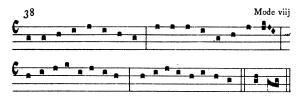Several things are conspiring to make me think about chant this morning. I’ve been splitting the Sarum hymn tunes into discrete jpeg files—like this one:
suitable for for use at Matins with Aurora lucis utilat and Lauds with Sermone blando Angelus. Too, at breakfast my Shuffle turned up the Enigma track that samples the Kyrie from the Missa Orbis Factor. Furthermore, I was looking at my blog stats. I get a lot of hits from Office hymn titles or searches for the Liber usualis.
One of the most common, though, is “Liber Usualis modern notation”. If you came here through this search term, I’ll make a quick comment on this topic. I don’t have one here and you’re not likely to find one. Why? Well—it’s about time economies. It would take an awful lot of time to translate the notation from the Liber into modern notation and the genuine fact is that the modern notation version would be inherently inaccurate because of the differences between modern music and chant. Even modern chant notation wouldn’t really do the trick.
So, that’s one half of the time economy; it would take a lot of time to produce it and the result would be imperfect. Now—here’s the other part. Chant notation only looks intimidating; it can be learned quite easily. Once learned, you can use it to read all sorts of things that go beyond the Liber. If you want to learn, I’d recommend starting with this excellent introduction, then download the Liber usualis, and go to your cd collection. If you have some basic chant cds—like “Chant” and “Chant II” from de Silos produced a few years back—cue a track, locate the chant in the Liber, and sing along. Start with the simple, then go from there. And look here for links to more introductions, scores, and audio files.

I’m with you; square-note chant notation – while a little confusing at first, perhaps – is actually easier, I think, than the modern.
It could just be my imagination, I guess, but I like the dynamics and tempo/timing notation better, and it’s built right in.
I have actually been following along with the liturgical year lately on Chantblog, and posting hymns and things as the feasts occur. So we should probably put our work together at some point, because I’ve been able to find sound files for many of these hymns.
BTW, have you seen this? Thought you’d be interested, if not….
I once wrote a brief note arguing that singing chant from square notes is like eating Chinese food with chopsticks:
1) It’s the right way to do it,
2) It’s not all that hard once you get the hang of it, and
3) For some mysterious reason the food tastes better.
My tongue was only partially in my cheek.
I’ve used the Meinrad fonts from St. Meinrad Abbey? It takes a while to get used to them, but after a while it becomes natural. The neat thing is they can be used in a word processor. This may already be old ground for you, but I thought I’d mention it just in case.
Yes, I’ve seen and experimented with those. But what’s found favor in these parts is a gem that bls dug up a while back: Gregoire
PH and I made a modern notation version of the ordinaries from Orbis Factor (cleaned up and put into finale by our friend who is an actual composer) and it took half. a. lifetime.
but we do have it.
I’ve never been able to manage chopsticks either.
hey…I emailed your school account about a party for kizzy. not trying to be pressuring, just worried maybe you don’t check that account. :)
Thanks for the link to Gregoire. I’ve downloaded it and mean to give it a whirl. Luckily, French is a language I can speak, so that will make the help files more helpful!
Pingback: Liber Usualis Modern Notation in English « haligweorc